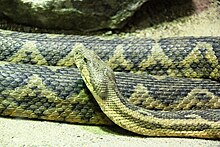| Moorish viper | |
|---|---|

| |
| Conservation status | |
 Near Threatened (IUCN 3.1) | |
| Scientific classification | |
| Domain: | Eukaryota |
| Kingdom: | Animalia |
| Phylum: | Chordata |
| Class: | Reptilia |
| Order: | Squamata |
| Suborder: | Serpentes |
| Family: | Viperidae |
| Genus: | Daboia |
| Species: | D. mauritanica |
| Binomial name | |
| Daboia mauritanica (Duméril & Bibron, 1848) | |

| |
| Synonyms | |
| |
The Moorish viper (Daboia mauritanica or Macrovipera mauritanica; common names: Moorish viper, Sahara rock viper, Atlas blunt-nosed viper, more) is a viper species found in northwestern Africa. No subspecies are currently recognized.

Description
Reaches a maximum length of 180 cm.
Common names
Moorish viper, Sahara rock viper, Atlas blunt-nosed viper, Atlas adder, mountain adder.
Geographic range
Northwestern Africa: Morocco, Algeria and Tunisia. The type locality is "Algiers", according to Gray (1842), "Algeria" according to Schwarz (1936). Limited to the coastal regions of Algeria. Coastal records from Tunisia may refer to M. deserti.
Conservation status

This species is classified as Near Threatened (NT) according to the IUCN Red List of Threatened Species (v3.1, 2001). Classified as such because this species is likely in significant decline (but at a rate of less than 30% over ten years) due to persecution, accidental mortality and over-harvesting, therefore making it close to qualifying for Vulnerable. The population trend is down. Year assessed: 2005.
Taxonomy
Based on molecular evidence, Lenk et al. (2001) suggested that this species, along with M. deserti, should rather be included in the genus Daboia.
References
- ^ McDiarmid RW, Campbell JA, Touré T. 1999. Snake Species of the World: A Taxonomic and Geographic Reference, vol. 1. Herpetologists' League. 511 pp. ISBN 1-893777-00-6 (series). ISBN 1-893777-01-4 (volume).
- ^ Mallow D, Ludwig D, Nilson G. 2003. True Vipers: Natural History and Toxinology of Old World Vipers. Krieger Publishing Company, Malabar, Florida. 359 pp. ISBN 0-89464-877-2.
- ^ U.S. Navy. 1991. Poisonous Snakes of the World. US Govt. New York: Dover Publications Inc. 203 pp. ISBN 0-486-26629-X.
- ^ Mehrtens JM. 1987. Living Snakes of the World in Color. New York: Sterling Publishers. 480 pp. ISBN 0-8069-6460-X.
- "Macrovipera mauritanica". Integrated Taxonomic Information System. Retrieved 9 August 2006.
- ^ Spawls S, Branch B. 1995. The Dangerous Snakes of Africa. Ralph Curtis Books. Dubai: Oriental Press. 192 pp. ISBN 0-88359-029-8.
- Brown JH. 1973. Toxicology and Pharmacology of Venoms from Poisonous Snakes. Springfield, Illinois: Charles C. Thomas. 184 pp. LCCCN 73-229. ISBN 0-398-02808-7.
- Daboia mauritanica at the IUCN Red List. Accessed 2 September 2007.
- 2001 Categories & Criteria (version 3.1) at the IUCN Red List. Accessed 2 September 2007.
- Lenk P, Kalyabina S, Wink M, Joger U (April 2001). "Evolutionary relationships among the true vipers (Reptilia: Viperidae) inferred from mitochondrial DNA sequences". Molecular Phylogenetics and Evolution. 19 (1): 94–104. doi:10.1006/mpev.2001.0912. PMID 11286494.
External links
- Daboia mauritanica at the Reptarium.cz Reptile Database. Accessed 9 August 2007.
- Video of Macrovipera mauritanica on YouTube. Accessed 9 September 2007.
| Taxon identifiers | |
|---|---|
| Daboia mauritanica | |